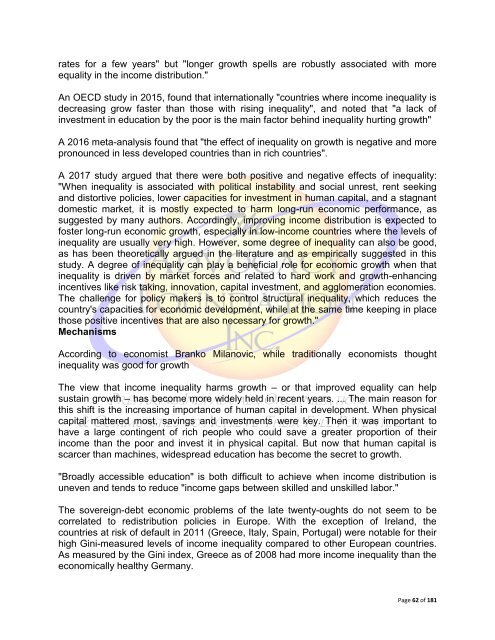You also want an ePaper? Increase the reach of your titles
YUMPU automatically turns print PDFs into web optimized ePapers that Google loves.
ates for a few years" but "longer growth spells are robustly associated with more<br />
equality in the income distribution."<br />
An OECD study in 2015, found that internationally "countries where income inequality is<br />
decreasing grow faster than those with rising inequality", and noted that "a lack of<br />
investment in education by the poor is the main factor behind inequality hurting growth"<br />
A 2016 meta-analysis found that "the effect of inequality on growth is negative and more<br />
pronounced in less developed countries than in rich countries".<br />
A 2017 study argued that there were both positive and negative effects of inequality:<br />
"When inequality is associated with political instability and social unrest, rent seeking<br />
and distortive policies, lower capacities for investment in human capital, and a stagnant<br />
domestic market, it is mostly expected to harm long-run economic performance, as<br />
suggested by many authors. Accordingly, improving income distribution is expected to<br />
foster long-run economic growth, especially in low-income countries where the levels of<br />
inequality are usually very high. However, some degree of inequality can also be good,<br />
as has been theoretically argued in the literature and as empirically suggested in this<br />
study. A degree of inequality can play a beneficial role for economic growth when that<br />
inequality is driven by market forces and related to hard work and growth-enhancing<br />
incentives like risk taking, innovation, capital investment, and agglomeration economies.<br />
The challenge for policy makers is to control structural inequality, which reduces the<br />
country's capacities for economic development, while at the same time keeping in place<br />
those positive incentives that are also necessary for growth."<br />
Mechanisms<br />
According to economist Branko Milanovic, while traditionally economists thought<br />
inequality was good for growth<br />
The view that income inequality harms growth – or that improved equality can help<br />
sustain growth – has become more widely held in recent years. ... The main reason for<br />
this shift is the increasing importance of human capital in development. When physical<br />
capital mattered most, savings and investments were key. Then it was important to<br />
have a large contingent of rich people who could save a greater proportion of their<br />
income than the poor and invest it in physical capital. But now that human capital is<br />
scarcer than machines, widespread education has become the secret to growth.<br />
"Broadly accessible education" is both difficult to achieve when income distribution is<br />
uneven and tends to reduce "income gaps between skilled and unskilled labor."<br />
The sovereign-debt economic problems of the late twenty-oughts do not seem to be<br />
correlated to redistribution policies in Europe. With the exception of Ireland, the<br />
countries at risk of default in 2011 (Greece, Italy, Spain, Portugal) were notable for their<br />
high Gini-measured levels of income inequality compared to other European countries.<br />
As measured by the Gini index, Greece as of 2008 had more income inequality than the<br />
economically healthy Germany.<br />
Page 62 of 181

















